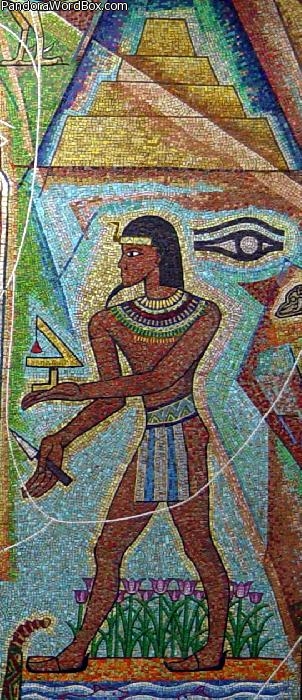Our websites offer information mostly for educational purposes with no intent to alter health care protocols nor to serve as a sole source of medical information.
Always seek the advice of your local health care provider.
|
× UKRAINIAN CHILDREN WITH DISABILITIES HAVE SPECIAL NEEDS |
IMHOTEP

"Imhopt or Imhotep" (details from "History of Medicine Mosaic") (see related A | B), 1960 A. Conrad Albrizio Lobby University Hospital of the University of South Alabama, Mobile, Alabama, USA
The plumb and the scalpel in conjunction with the sacred asp (cobra) and eye (emblems of the sun, light, vision and providence) represent scientific humanistic medicine. Imhotep is the first architect, physician, and polymath known by name. He is mostly remembered for having built the first Pyramid in Egypt known as the "Step Pyramid" (shown above him and on every U$D 1 bill). He also liberated medicine from magic-religious suffocation. Some assert that he invented the papyrus scroll (paper) and the use of columns in architecture.
Imhotep (c. 2600 B.C.) or Imhopt, Immutef, Im-hotep, li-em-Hotep, Imuthes is a pillar of the history of civilizations. He served king Djoser as his chancellor and in Heliopolis, as high priest of the sun god Ra (akin to the Greek Helios or Apollo). He was the only mortal to be represented by statues along with Pharaohs. He is reported to be the inventor of "healing". In appreciation, some 2000 years after his death, he was elevated from mortal to the status of divine (akin to "sainthood"). Similarities of Aesculapius to Imhopt are obvious. He was a mortal who centuries after his death was elevated to a divine status (c. 300 BC). His father was imagined to be Helios (Apollo, the healer). William Osler called Imhotep and not Aesculapius, the real "Father of Medicine".
20200901 ww
|








